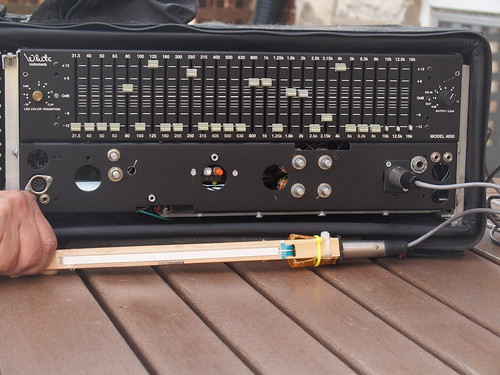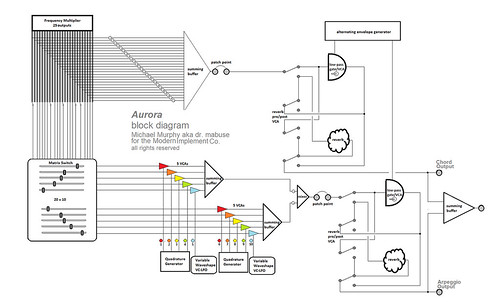The Aurora
A study in contrasts
This is one UGLY machine. And she breaks ALL my rules.
The Aurora is named for her sound, and that sound is consistently beautiful. And not ‘beautiful’ in one of my wry, conceptual, deconstructionist ways, either. Beautiful, in the common sense of the word; attractive and alluring. Her voice can be bright and animated, or eerie and haunting but it always has an ethereal shimmer to it that puts me in mind of the Northern Lights . Hence the name
It is very common for me to include her in performances that also involve the Dome, and based on frequent comments, most audience members invariably assume that the sounds that are coming from the Aurora are being generated by the Dome (which is usually making very sharp pointilistic chatter). That makes the Aurora sort of the Marni Nixon in my cast of characters.
In the rule breaker category she also excels. Her core is not only a commercial module, it is a digital oscillator(!) Actually 25 digital oscillators in point of fact (!!) If you have read any of my other articles you probably realize that for me to start a signal chain with a commercial DIGITAL oscillator, that oscillator would have to be something REALLY special.
It is…
It’s the ‘Patch Chord’ by Erthenvar. It works like this. It accepts a single audio tone in an input and then, by digital processing it synthesizes 24 new waves that are all perfect fixed intervals from the pitch of the input tone. These intervals are selectable as either, two 12-note octaves of equal-tempered chromatic intervals or 24-pitches that follow the natural integer harmonic series. All 25 tones are available simultaneously on front panel jacks. When I saw a synthesist use one for the first time, he had tapped only a handful of the outputs. But my mind reeled when I considered the sound that would be possible if you could hear all 25 tones mixed, with a 25-channel mixer. And thanks to a charitable sound-tech who retired his failing gear in my salvage pile I had an array of 25 slide-pots all neatly lined up and ready to go!
I re-routed the traces on the discarded White Instruments graphic equalizer (depicted) and made a compact mixer of it. The ‘all faders up’ sound was very impressive on it’s own. But to be truly more than just a massive novelty, a more sophisticated animation scheme was needed. It might be helpful to consult the block diagram below. I say ‘might’ because the Aurora is a very complicated device. Apprehending the signal flow takes some concentration.
The Erthenvar oscillator is in the upper left corner. 25 tones all take a forked path to the rest of the device. The top horizontal path is the ‘Chord’ path. The lower vertical path is the ‘Arpeggio’ path and will be covered later.
The Chord channel
The Chord path routes all 25 tones through a 25 channel mixer. The mixed signal is routed to an ‘insert’ set of patch points with a send & return. From the return patch point, the processed signal is sent through a configurable VCA & Reverb path to a final stage output.
The animation for the chord depends on what is inserted between those patch points. Any audio processor could be inserted there but I built a custom modular system especially for this application.
This modular contains a utility module with a 3 channel Mixer, and 3 LFO’s and 2 smooth random CV generators. This utility module is aboard to provide CV’s for a 4-Band Resonator modelled on the resonator in the Korg PS-3100 , and for one of the lushest sounding VCF’s I’ve ever heard. Grant Richter’s spectacular “Omni Filter”. The Omni Filter has the powerful and unique ability to smoothly shift modes from low-pass, to band-pass, to high-pass, to All-pass (phase-shift) under voltage control. For the Aurora system I usually use an slow LFO to slowly drift between the low-pass and band-pass modes. The band-pass sweeps do a beautiful job of dynamically isolating or ‘spotlighting’ particular tones in the dense chord mix and, combined with the four constantly shifting bands of resonance from the resonator. The thickly massed chord tones take on a buoyant, floating quality.
The Arpeggio Channel
The Arpeggio Channel allows the user to select 10 tones (2 groups of 5-each) from the 25 available tones. This selection is done with a matrix-slide-switch. The selected tones are then routed through 10 VCAs, split into two parallel channels of 5 each. In each group of 5, 4 of the VCAs (red, orange, yellow, & green in the diagram) are controlled by a quadrature* triangle-wave LFO, and one of the VCAs (blue in the diagram) is controlled by a dedicated variable-waveshape modulator. This modulation grid produces 2 rotating 5-note arpeggios that rotate at speeds controlled by control voltages.
The Output, Reverb, VCO, and Control Stages
The Chord and Arpeggio channels are each passed through a VCA which can be switched between two modes: conventional linear VCA, or a Buchla-style optical Low-Pass Gate. The VCAs are controlled by a control voltage generator that can crossfade or overlap the two signals . Each channel also has a reverb which can be routed either pre, or post VCA and the final VCA stages are summed to a single output.
The VCO that provides the base-tone for the Erthenvar Oscillator has control voltage inputs for pitch and I implemented a small dedicated ribbon controller (seen in 2nd photo from top). There are several smooth and stepped-random control voltage generators onboard as well.
As for the box…
Well, I said at the outset that this was an UGLY electronium; strict utility, and NO ART HERE! There is a LOT of circuitry inside and so it’s a bulky and somewhat unwieldy device. I didn’t want to add a lot of additional weight with the enclosure, so I recycled an old lightweight nylon-covered FX-rack which even had a zippered pocket on it that was almost big enough for the ribbon.
She’s not much to look at. But with your eyes closed, she’s a siren of surpassing beauty if I do say so myself.
An Explanatory Video Courtesy of the Hearding Cats Collective
*’quadrature’ in this context means that there are 4 triangle modulation waves whose phases are offset from each other by 90-degrees.





Comments are closed.